|
||||||
| Suspension | Chassis | Brakes -- Sponsored by 949 Racing Relating to suspension, chassis, and brakes. Sponsored by 949 Racing. |
 |
|
|
Thread Tools | Search this Thread |
|
|
#1 |
|
Frosty Carrot
Join Date: Jan 2013
Drives: The Atomic Carrot
Location: Baltimore, MD
Posts: 513
Thanks: 272
Thanked 428 Times in 199 Posts
Mentioned: 19 Post(s)
Tagged: 0 Thread(s)
|
The 2nd Official Shock Dyno Thread
Shoutout to @GTM_Challenge for starting this discussion (Link to Thread), @RaceComp_Engineering and @Dave-ROR for the contributions in their monster thread.
There's alot of great information scattered throughout the Interballz about dampers and shock dyno data. I'm hoping to consolidate things for the 86 community. First off... the terms: damper, dashpot, shock absorber, shock, dampeners, etc are all the same thing. They are transducers that convert one form of energy to another. Movement (velocity) is turned into heat. They can be compared to an electrical resistor, friction, or a nozzle (fluid flow through a small orifice). Good reference material: Link to OptimumG's Technical Papers (highly recommended) Link to Westfield Guide Link to Roehrig Dynos Link to Penske troubleshooting Link to Penske Double Adjustable Manual Link to Tein's guide *insert more stuff here* Things we care about: Natural frequency This is the frequency at which a spring-mass system will vibrate/resonate at from a step input. Looks like this:  You can calculate it using this:  where k = spring rate (in kg/s^2)Generally,
Our OEM natural frequencies are: Front = 1.37 Hz Damped Natural Frequency When you introduce a damper, it affects the system. You move from this governing equation of motion:  to this:  The first term describes the acceleration and forces. The second term describes the damping and loss terms. The third term describes the spring and restorative terms. The terms can be connected back to real parameters:  where w_o = natural frequency (in radians)and  where zeta = damping ratio (unitless) Damping Ratio Many theory guys will tell you that zeta = 0.707 is the best, and I tend to agree. Many tuners will tell you zeta = 0.65, which is just fine too. You want to choose a value that has the right mix of rise time, settling time, overshoot, and steady-state bias. Unless your suspension is ridiculously overdamped, you probably won't have steady-state bias. Rise time is important, but not the most relevant to the discussion right now. Let's focus on settling time and overshoot (which are related). Settling time is the amount of time it takes for a system to recover from a step change. Generally, we talk about 95% settling time which means you won't see any more deviations beyond (0.95, 1.05). Overshoot is relatively simple topic. Here's what a few different values look like: 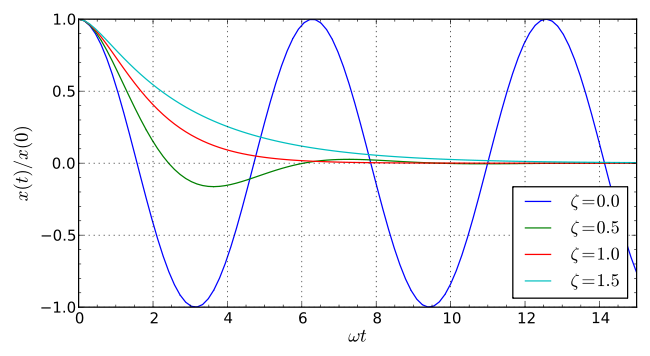 For zeta = 0.5, you can estimate the 95% settling time to be ~5, and the overshoot to be 15%. General suggestions: low speed (< 2 [Front] or 1.56 [Rear] in/sec) compression = 0.66As you can guess, this means we'll be soft during speed bumps, well-controlled during normal humps in the road, and sluggish when going over potholes. Google Doc that I'm attempting to fill with shock data: LINK to Google Doc List of Shock Dyno Data: OEM SHOWA:  RaceComp Engineering Tarmac T2: Front Rear KW Clubsport: Front  Rear 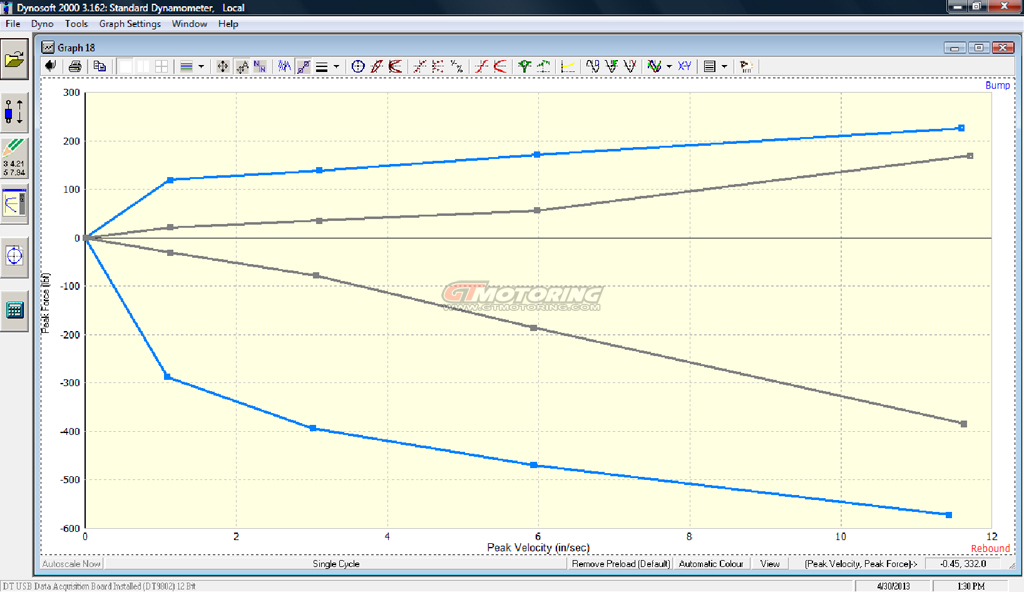 Fortune Auto 500 series:  Ohlins DFV: Front  Rear 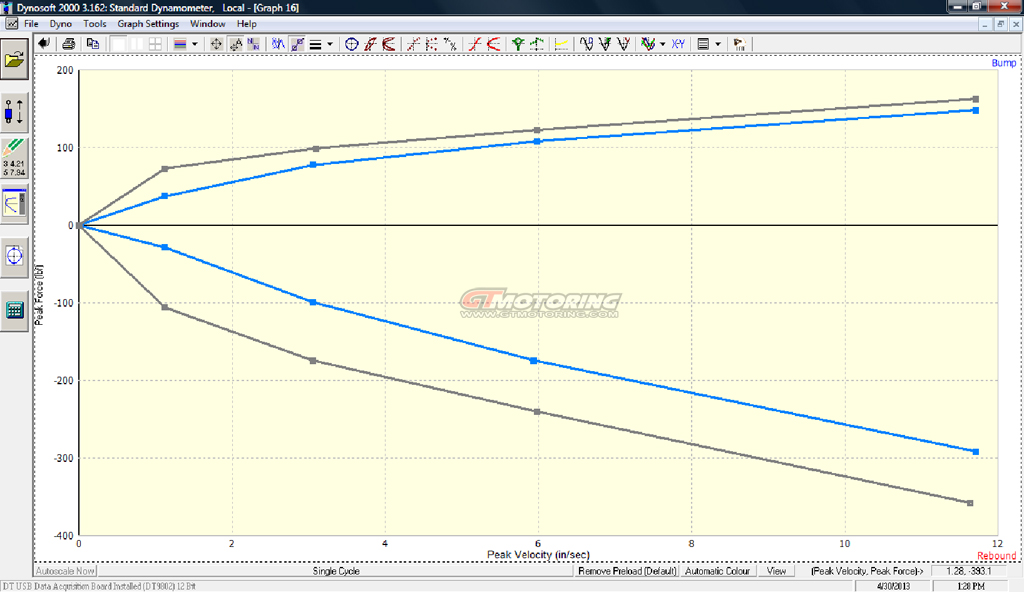 ISC N1: 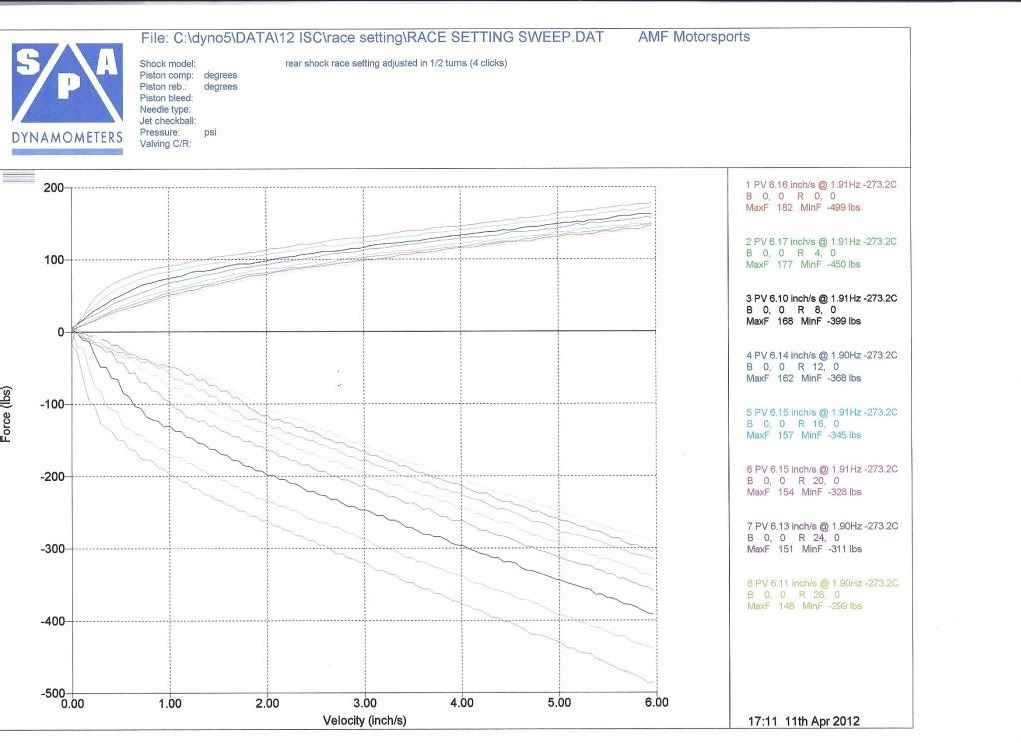 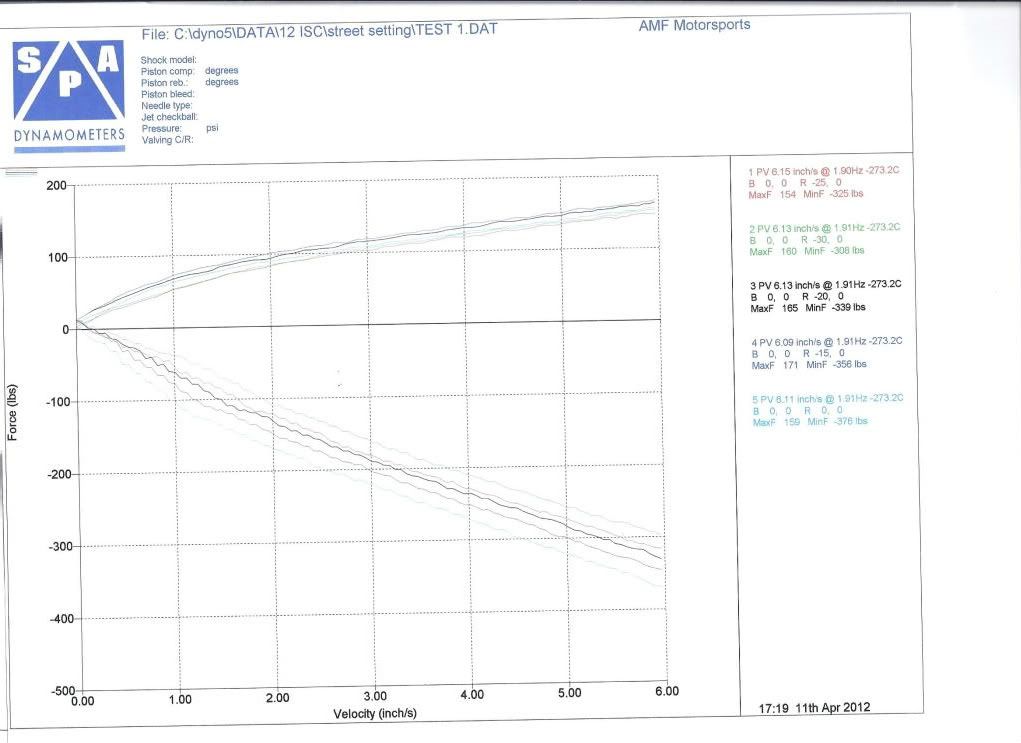 OEM Springs: 
__________________
If you think you're nerd enough, join in the discussions about Suspension and Aerodynamic modelling!
Wall of Fame - JDL Auto Design, Raceseng, Vishnu Tuning, Penske Shocks, Nameless, Perrin, RaceComp Engineering, Essex/AP Racing, Verus, RacerX Wall of Shame - aFe Takeda, Wilwood, FA20Club Last edited by Shankenstein; 08-05-2014 at 12:57 PM. |
|
|

|
| The Following 13 Users Say Thank You to Shankenstein For This Useful Post: | akahenry (07-31-2014), AlphaMotorsports.ca (07-31-2014), Creole (08-01-2014), DarkSunrise (11-15-2015), Fastbrew (08-01-2014), fstlane (07-31-2014), GotBRZ1691 (07-31-2014), Jyn (03-11-2020), Sleepless (08-01-2014), solidONE (07-31-2014), Turdinator (07-31-2014), Wepeel (08-04-2014), Yoniyama (03-14-2020) |
|
|
#2 | |
|
Senior Member
Join Date: May 2011
Drives: '23 BRZ
Location: Providence, RI
Posts: 4,584
Thanks: 1,376
Thanked 3,890 Times in 2,032 Posts
Mentioned: 85 Post(s)
Tagged: 0 Thread(s)
|
Quote:
Front spring rate is 156 lb/in = 27328 N/m Front motion ratio is ~0.95 Front wheel rate is 27328 N/m * 0.95^2 = 24663 N/m Front weight is ~2915 lb *.54 = 1574 lb. Weight on one front wheel = 787 lb. = 357 kg Unsprung mass ~55 lb. = 25 kg Sprung mass at one front corner ~357 kg - 25 kg = 332 kg f = 1/2pi * sqrt(k/m) = 1/2pi * sqrt(24663 N/m / 332kg) = 1.37 Hz Going through the rear using 198 lb/in spring rate, 0.75 motion ratio, and 280kg sprung mass at one rear corner, I get 1.33 Hz for the rear. 2 Hz is pretty unheard of for "normal" stock street cars. Very stiff for a production car. My FD on 13kg front 11kg rear springs is at 2 Hz (1.96F/2.03R), and it's *way* stiffer than a BRZ! Last edited by ZDan; 07-31-2014 at 08:04 AM. |
|
|
|

|
|
|
#3 | |
|
Junior
Join Date: Aug 2013
Drives: a car
Location: Probably at school
Posts: 4,341
Thanks: 3,184
Thanked 2,512 Times in 1,502 Posts
Mentioned: 20 Post(s)
Tagged: 0 Thread(s)
|
Quote:
Fairly good reference article: http://www.rqriley.com/suspensn.htm
__________________
"Ah! What music! They could have never imagined, those pioneers who invented the automobile, that it would posses us like this, our imaginations, our dreams. Men love women, but even more than that, men love CARS!"-Lord Hesketh
|
|
|
|

|
|
|
#4 |
|
Off the top of my head, I think those natural frequencies are quite high. I've had a few beers but they're not that high stock. More like 1.3 to 1.5 ish.
I'll try to contribute some...umm...later. - Andy |
|
|
|

|
| The Following 3 Users Say Thank You to Racecomp Engineering For This Useful Post: |
|
|
#5 |
|
Senior Member
Join Date: May 2011
Drives: '23 BRZ
Location: Providence, RI
Posts: 4,584
Thanks: 1,376
Thanked 3,890 Times in 2,032 Posts
Mentioned: 85 Post(s)
Tagged: 0 Thread(s)
|
c is not "ideal damper piston speed". c is damping in units of force per velocity. In SI units, Newtons over meter-per-second, or N/(m/s), often shown as N-s/m. For shocks c is not constant, as shown in the plots c is ideally higher for low shock speeds and lower for higher speeds, continuing to decline with velocity. A shock with a constant c would just be a straight line starting at zero and increasing linearly with velocity.
|
|
|

|
|
|
#6 |
|
Senior Member
Join Date: Dec 2012
Drives: FR-S Whiteout
Location: California
Posts: 2,863
Thanks: 1,808
Thanked 790 Times in 611 Posts
Mentioned: 42 Post(s)
Tagged: 0 Thread(s)
|
Ahem... dampeners...
subed. 
|
|
|

|
|
|
#7 |
|
Senior Member
Join Date: May 2011
Drives: '23 BRZ
Location: Providence, RI
Posts: 4,584
Thanks: 1,376
Thanked 3,890 Times in 2,032 Posts
Mentioned: 85 Post(s)
Tagged: 0 Thread(s)
|
|
|
|

|
|
|
#8 | |
|
Frosty Carrot
Join Date: Jan 2013
Drives: The Atomic Carrot
Location: Baltimore, MD
Posts: 513
Thanks: 272
Thanked 428 Times in 199 Posts
Mentioned: 19 Post(s)
Tagged: 0 Thread(s)
|
Quote:
Guilty as charged. No excuse, Drill Sargent! From the suspension modeling thread, I've copy-pasta'd this: Front (FR-S) = 1.24 HzIt's not exactly your 1.37 & 1.33 Hz values, but we're atleast away from the 2.1 Hz value before (Doet!).
__________________
If you think you're nerd enough, join in the discussions about Suspension and Aerodynamic modelling!
Wall of Fame - JDL Auto Design, Raceseng, Vishnu Tuning, Penske Shocks, Nameless, Perrin, RaceComp Engineering, Essex/AP Racing, Verus, RacerX Wall of Shame - aFe Takeda, Wilwood, FA20Club |
|
|
|

|
|
|
#9 |
|
Senior Member
Join Date: May 2011
Drives: '23 BRZ
Location: Providence, RI
Posts: 4,584
Thanks: 1,376
Thanked 3,890 Times in 2,032 Posts
Mentioned: 85 Post(s)
Tagged: 0 Thread(s)
|
Those numbers are also too high. Looks like they incorrectly multiplied the spring rates by the motion ratios to get the wheel rates. You have to multiply spring rate by the SQUARE of the motion ratio to get the wheel rate.
|
|
|

|
| The Following User Says Thank You to ZDan For This Useful Post: | wparsons (07-31-2014) |
|
|
#11 |
|
Senior Member
Join Date: Oct 2013
Drives: 2015 WRX
Location: NC
Posts: 987
Thanks: 186
Thanked 624 Times in 364 Posts
Mentioned: 24 Post(s)
Tagged: 0 Thread(s)
|
http://grammarist.com/usage/dampen-damper-dampener/
They mean essentially the same thing in this instance. @Racecomp Engineering : Do you have the T2 charts available to add to this thread? |
|
|

|
| The Following User Says Thank You to Malt For This Useful Post: | solidONE (07-31-2014) |
|
|
#12 | |
|
Quote:
- Andy |
||
|
|

|
| The Following 2 Users Say Thank You to Racecomp Engineering For This Useful Post: | AlphaMotorsports.ca (07-31-2014), Malt (07-31-2014) |
|
|
#13 |
|
Frosty Carrot
Join Date: Jan 2013
Drives: The Atomic Carrot
Location: Baltimore, MD
Posts: 513
Thanks: 272
Thanked 428 Times in 199 Posts
Mentioned: 19 Post(s)
Tagged: 0 Thread(s)
|
Main post updated. Some errors fixed, and hopefully it flows better.
__________________
If you think you're nerd enough, join in the discussions about Suspension and Aerodynamic modelling!
Wall of Fame - JDL Auto Design, Raceseng, Vishnu Tuning, Penske Shocks, Nameless, Perrin, RaceComp Engineering, Essex/AP Racing, Verus, RacerX Wall of Shame - aFe Takeda, Wilwood, FA20Club |
|
|

|
|
|
#14 |
|
Senior Member
Join Date: May 2011
Drives: '23 BRZ
Location: Providence, RI
Posts: 4,584
Thanks: 1,376
Thanked 3,890 Times in 2,032 Posts
Mentioned: 85 Post(s)
Tagged: 0 Thread(s)
|
Forgive me as I continue to nit-pick!
Confusing way to do the units. Spring rate is more logically done in units of force per distance rather than kg/s^2. Pounds per inch (lb/in) or Newtons per meter (N/m). Coilover springs are often rated in "kilograms per millimeter", but it's important to note that that is kilograms-FORCE per millimeter (kgf/mm). 1kgf = 9.81N. So you take spring rate in kgf/mm and multiply by 9810 to get the rate in N/m, which works in the equations. Ditto for the damping. Newtons per meter-per-second, N/(m/s) or N-s/m makes more sense to use than kg/s. In both cases, the units are actually the same if you swap N for kg-m/s^2, it's just a question of presenting them in a context that makes sense or not. Last edited by ZDan; 07-31-2014 at 04:33 PM. |
|
|

|
|
|
|
|
 |
| Thread Tools | Search this Thread |
|
|
 Similar Threads
Similar Threads
|
||||
| Thread | Thread Starter | Forum | Replies | Last Post |
| FI Dyno thread | swift996 | Forced Induction | 275 | 03-26-2024 11:57 AM |
| NA FR-S/BRZ Dyno Thread | myEFispissed | Engine, Exhaust, Transmission | 11 | 09-02-2023 09:28 PM |
| Stock FR-S/BRZ shock dyno & stock FR-S spring dyno | xwd | Tracking / Autocross / HPDE / Drifting | 16 | 08-07-2014 09:04 PM |
| Official MMA Thread | zigzagz94 | Off-Topic Lounge [WARNING: NO POLITICS] | 11 | 12-15-2009 10:59 PM |